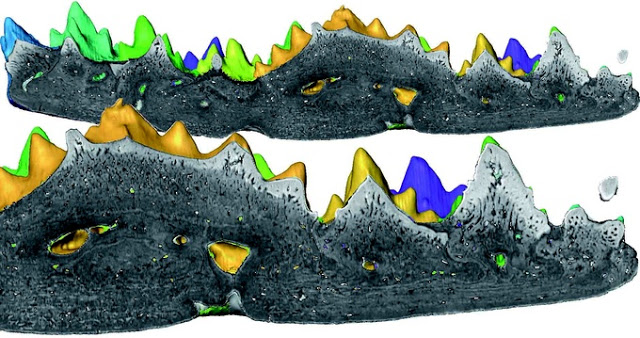
The tooth plate of just some millimeters in size had been in a box for more than 40 years, without being recognized after the discovery and preparation of the fish it belonged to. Palaeontologists from Naturalis Biodiversity Center, Netherlands and the University of Bristol, United Kingdom, studied the fossil using high energy X-rays at the Swiss Light Source at the Paul Scherrer Institut in Switzerland, revealing the structure and development of teeth and bones. Their findings are published today in Biology Letters.
Teeth are important in our daily life, they are crucial to munch and crunch our food. Jaws and teeth have been important innovations in the evolution of vertebrate animals. More than 98% of vertebrate animals have jaws.
Nevertheless earliest conditions and their origin are disguised in deep time. The search for fossil teeth of the earliest jawed vertebrates can literally be like the search for the needle in a haystack. This includes looking through boxes full of crumb sized bits and pieces of fossils remaining after dissolving rocks in acid.
Lead author, Martin Rücklin of Naturalis Biodiversity Center in Leiden says: “We were able to visualize the finest internal structures and distinguish tissues inside one of the first tooth plates. With powerful computing we combined thousands of X-rays and produced computer models reconstructing the growth of the first teeth.”
Philip Donoghue from the University of Bristol in the UK explains: “We show that the earliest teeth were like our own – but also structured like body scales in primitive fishes. This supports the view that teeth evolved from scales, which arose much earlier in vertebrate evolution.”
Rücklin adds: “Our results suggest that teeth originated deeper in the tree of life than we thought. We will have to look into more basal jawed vertebrates and also jawless fossils. Earliest jaws and teeth seem to be less integrated than we thought and teeth look more complex than expected. I am very happy that my research and our collaboration will be supported by the Vidi-grant of the Netherlands Organization for Scientific Research (NWO) in the next five years, enabling us to investigate these early stages of teeth and how the complex system of our own jaws and teeth evolved.”
Video
Reference:
M. Rucklin, P. C. J. Donoghue. Romundina and the evolutionary origin of teeth. Biology Letters, 2015; 11 (6): 20150326 DOI: 10.1098/rsbl.2015.0326
Note: The above post is reprinted from materials provided by Naturalis Biodiversity Center.










